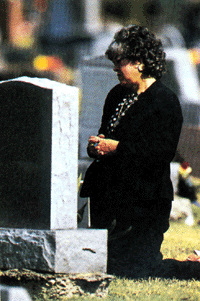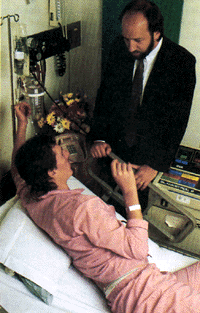The physician-assisted-killing fallacy
By Robert W. Evans, Ph.D.
 This article was written as the result of a panelist discussion (“California Capital Week,” Ch. 6, Sacramento) in which California Assemblywoman Dion Aroner proposed legislation that seeks to legalize physician-assisted suicide in the state of California.
This article was written as the result of a panelist discussion (“California Capital Week,” Ch. 6, Sacramento) in which California Assemblywoman Dion Aroner proposed legislation that seeks to legalize physician-assisted suicide in the state of California.
As with most discussions concerning bioethical tensions in our society, the arguments voiced by the panelists began at the wrong end of the question involved. Here we review only a few of the numerous questions that ought to be pursued, albeit, in brief when speaking of the legalization of what has been called “physician-assisted” suicide.
First, it has long remained a fixity within the Western medical tradition that the physician should, primum non nocere—“First of all, do no harm.” American medicine has largely spurned this Hippocratic maxim over the past twenty-five years following the landmark January 1973 Supreme Court decision, Roe v. Wade. In evidence of how far our culture has slipped in such a brief period of time, consider how few in our society even bother to ask whether physicians have the right to kill certain patients but merely assume that they do and now argue only about how and when, along with whether or not patients have the right to be killed.
Second, one has to wonder whether or not the legalization of physician-assisted suicide will serve to further erode public confidence in medicine. It is, perhaps, no coincidence that we are now entertaining the thought of legalizing physician-assisted suicide in our society following the legalization of abortion in 1973. You will recall that the opponents of abortion predicted that legalization of the same would lead to the approval of physician-assisted suicide and euthanasia—a charge that the proponents of abortion vehemently denied at the time. Time has told the truth and here we stand. To date, I have heard exceedingly few even broach this issue.
In the thinking of many, the bioethical agenda in our society has already allowed the camel to poke its nose under the tent. Several questions naturally follow: How much more ought we to allow? Will this lead to euthanasia? What affect would the Americans with Disabilities Act have upon this proposed bill which seeks to secure a right for some that would not be available to all? If a patient could not self-administer the lethal medication due to physical or mental incapacity, does not the ADA require that such individuals be afforded the same rights and privileges as the rest of us? It would seem that the lethal dosage would need to be administered to physically and mentally disabled people by someone else. This would rapidly move us from a situation in which we are “allowing someone to die,” to “causing someone to die.” This represents far more than a subtle shift in semantics. It represents a tremendous shift in culture. For once we become comfortable with the notion of “causing” someone’s death, where do we go from there?
Third, John Brooke, president of Americans for Death with Dignity, stated in substantial form on the Capital Week program that those of religious conviction do not have the right to legislate their morality for those who do not hold to the same beliefs. With all due respect to Mr. Brooke (and despite being often heard in today’s public arena), such an argument is both faulty and naïve. All laws are a reflection of the moral consensus of the constituency which they govern. Indeed, laws are the embodiment of a culture’s morality. The argument that one ought not, or cannot, legislate morality is appalling nonsense.
All laws are moral laws. Laws instruct us as to what one ought to do or ought not to do. Questions or issues that contain the sentiment of “ought” are inherently moral. The question is not whether one has the right to introduce his or her morality into laws, but rather, whose morals will the laws reflect? Furthermore, all questions of morality may be evaluated from either a secular or religious perspective. Why should only religious perspectives be barred from shaping the public square while secular views are embraced as the “neutral” or default setting to which our culture must dial its moral bearings and begin its discussions of contemporary issues?
Furthermore, how does the postmodernist, secular humanist, feminist, or atheist excuse themselves from their own criticisms? After all, each of these systems is but an alternative interpretative scheme set within its own presuppositions, pre-understandings and biases. Why is it that only the religious paradigm must be held in contempt by our society and excluded from shaping the moral contours of legislative initiatives?
Moreover, medicine adopted the Hippocratic Oath and refashioned its pagan roots in light of first century Christian revelation. Medicine has since been practiced as an inherently moral art grounded upon Judeo-Christian ethics. For Mr. Brooke to suggest that those of religious faith should not bring their values and morals to bear on our society’s decision whether or not to legalize physician-assisted suicide is patently absurd. A far more appropriate and compelling question is to ask Ms. Aroner and Mr. Brooke what values and morals are so powerful as to justify tearing the practice of medicine in the West from its Christian foundation? This is the default setting!
Fourth, does it not seem highly odd that legislative initiatives are at once determined to increase the care and provisions made available for the disabled, the aged, and the medically indigent, while simultaneously pressuring for health care rationing and the promotion of physician-assisted suicide as the appropriate means by which to deal with human suffering and the need to reduce medical costs? Such represents a fundamental contradiction that has yet to be addressed by proponents of initiatives such as California Assembly Bill Number 1592.
Fifth, there seems to be this notion afloat today that whether one possesses dignity or not largely revolves around the question of suffering. Under modern parlance, it is simply undignified to suffer. It is as if suffering, somehow, reduces a person to a state that is incompatible with dignity. Beyond the curious question of why our society has become concerned for a person’s dignity only when he is dying (e.g., Why not a movement focused on “Life with Dignity”?), several additional problems remain.
Like most arguments for physician-assisted suicide, Ms. Aroner has packaged her bill in the following form: Physician-assisted suicide should be allowed if, while the person is suffering greatly, he or she makes a request for assistance in dying.
 The packaging is clever because to the unwary consumer and untrained eye this appears to be but a single argument. However, upon closer examination we can readily identify two separate and distinct elements in this argument: autonomy and suffering.
The packaging is clever because to the unwary consumer and untrained eye this appears to be but a single argument. However, upon closer examination we can readily identify two separate and distinct elements in this argument: autonomy and suffering.
Indeed, Ms. Aroner made use of the term, “autonomy,” on several occasions. However, I wonder if she knows what the term means. Derived from two Greek terms: auto, meaning “self,” and nomos, meaning “law.” Autonomy maintains that each person is a lawgiver to himself or herself. Under such a view, each person has a right to self-determination in decision-making. However, the questions that were not entertained are these: If autonomy makes such a powerful claim in matters of physician-assisted suicide, how can we insist that the one exercising his autonomy must be suffering greatly? Don’t those who are not suffering greatly also possess a right to self-determination? Why must one be suffering greatly before he can exercise his autonomy? Those with emotional, financial, interpersonal, and mental problems are also autonomous. Why don’t they also have the right to exercise self-determination?
Additionally, if the suffering of others makes such a powerful claim upon us that we ought to kill those who are suffering, why should such a provision only be made available to those who are able to exercise autonomy and self-determination? Surely suffering is not restricted only to those who are autonomous! Aren’t the weak, mentally retarded, psychiatrically impaired, and the like, also liable to suffering? Should we extend similar rights to these people?
Sixth, Assemblywoman Aroner’s proposed legislation calls for the patient requesting death to be “terminally ill.” This is defined, as a condition believed by two or more physicians to likely result in death within six months. However, such prognostic capabilities in medicine are a myth. The Boston Globe reported in May of 1997 that among those who were believed by two or more physicians to have a “terminal diagnosis” (i.e., death was believed to be certain within six months), some 28-37% were still alive after six months. Moreover, some 18-28% were yet alive after one year!
Furthermore, there have been several studies revealing that when patients making a request for assistance with dying are given the option between death and pain relief, over 90% choose relief from pain. In short, dying patients don’t want to die, they want relief from pain. Ms. Aroner’s bill is pointed in the wrong direction.
Finally, when did it become good medical practice to eliminate suffering by eliminating the sufferer? Hippocrates never spoke of “ending suffering.” Rather, he spoke only of healing. It seems to me that if Hippocrates had been concerned with ending suffering, he would have prescribed rather than prohibited the administration of lethal drugs. Instead, he made a categorical distinction between healing and killing. Consistent with this view, Western medicine has historically acknowledged that while healing is often impossible, any notion of killing those who have entrusted their lives into the hands of the healer is unacceptable.
I could go on at some length (e.g., the research design and methodological flaws in polls of those favoring physician-assisted suicide, the role of psychology and psychiatry in evaluating mental illness among those requesting assistance with dying, the matrix of the mind in the dying process and its affect upon requests for physician-assisted suicide, the impact of shifts in medicine upon our sense of what it means to be human, the relationship between medicine and culture, etc.). But I trust that the above is sufficient to illuminate further discussions concerning this most important and pressing issue of social and moral concern. I assure you that the stakes involved far exceed anything that has been presently envisioned or discussed on programs like California Capital Week.
Abortion is not legal
Martin's Story: a holocaust paradox
Beware of feminist euphemisms
The physician-assisted-killing fallacy
The Race

